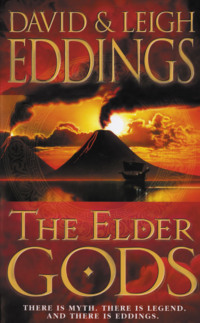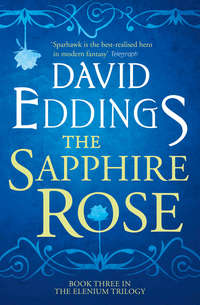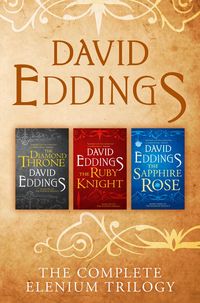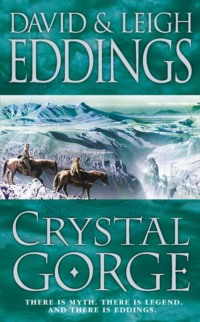
Полная версия
The Rivan Codex: Ancient Texts of The Belgariad and The Malloreon

The Rivan Codex
Ancient Texts Of The Belgariad And The Malloreon
David & Leigh Eddings

For Malcolm, Jane, Joy, Geoff and all the staff at HarperCollins.
It’s always a genuine pleasure to work with you. With all our thanks
DAVID & LEIGH
Table of Contents
Cover Page
Title Page
INTRODUCTION
PREFACE: THE PERSONAL HISTORY OF BELGARATH THE SORCERER*
I THE HOLY BOOKS
THE BOOK OF ALORN*
THE BOOK OF TORAK
TESTAMENT OF THE SNAKE PEOPLE
HYMN TO CHALDAN
THE LAMENT OF MARA
THE PROVERBS OF NEDRA
THE SERMON OF ALDUR
THE BOOK OF ULGO*
II THE BISTORIES
AT TOL HOPELB 5368
THE EMPIRE OF TOLNEDRA
UNIVERSAL WEIGHTS AND MEASURES*
THE ALORN KINGDOMS
SENDARIA*
ARENDIA
ULGOLAND*
NYISSA
THE ANGARAK KINGDOMS
III THE BATTLE OF VO MIMBRE
BOOK SEVEN THE BATTLE BEFORE VO MIMBRE
AFTERWORD
INTERMISSION
IV PRELIMINARY STUDIES FOR THE MALLOREON
A CURSORY HISTORY OF THE ANGARAK KINGDOMS
V THE MALLOREAN GOSPELS
BOOK 1 THE BOOK OF AGES
BOOK 2 THE BOOK OF FATES
BOOK 3 THE BOOK OF TASKS
BOOK 4 THE BOOK OF GENERATIONS
BOOK 5 THE BOOK OF VISIONS
VI A SUMMARY OF CURRENT EVENTS 5376-5387
From the Personal Journal of King Anheg of Cherek*
AFTERWORD
By David Eddings
Copyright
About the Publisher
INTRODUCTION
My decision to publish this volume was made in part because of a goodly number of flattering letters I’ve received over the past several years. Some of these letters have come from students at various levels, and to make matters worse, I’ve also received letters from teachers who inform me that they’re actually encouraging this sort of thing. Aren’t they aware that they’re supposed to wait until I’m safely in the ground before they do this?
The students, naturally, ask questions. The teachers hint around the edges of an invitation to stop by and address the class. I’m very flattered, as I mentioned, but I don’t write – or grade – term papers any more, and I don’t travel. To put it idiomatically, ‘I ain’t going no place; I been where I’m going.’
Then there are those other letters, the ones which rather bashfully confide an intention to ‘try writing fantasy myself’. I don’t worry too much about those correspondents. They’ll get over that notion rather quickly once they discover what’s involved. I’m sure that most of them will eventually decide to take up something simpler – brain surgery or rocket science, perhaps.
I’d more or less decided to just file those letters and keep my mouth shut. A prolonged silence might be the best way to encourage a passing fancy to do just that – pass.
Then I recalled a conversation I had with Lester del Rey on one occasion. When I’d first submitted my proposal for the Belgariad, I’d expected the usual leisurely reaction-time, but Lester responded with what I felt to be unseemly haste. He wanted to see this thing – now, but I wasn’t ready to let him see it – now. I was in revision of what I thought would be Book I, and since I was still doing honest work in those days, my time was somewhat curtailed. I wanted to keep him interested, however, so I sent him my ‘Preliminary Studies’ instead – ‘So that you’ll have the necessary background material.’ Lester later told me that while he was reading those studies, he kept telling himself, ‘There’s no way we can publish this stuff,’ but then he admitted, ‘but I kept reading.’ We were fairly far along in the Belgariad when he made this confession, and he went on to say, ‘Maybe when we’ve got the whole story finished, we might want to think about releasing those studies.’
Eventually, the two ideas clicked together. I had people out there asking questions, and I had the answers readily at hand since nobody in his right mind takes on a multi-book project without some fairly extensive preparation. My Preliminary Studies were right there taking up space, I’d just finished a five-book contract, and I had nothing else currently on the fire. All this thing needed was a brief introduction and some footnotes, and we were off to press. (Just in passing I should advise you that my definition of ‘brief’ and yours might differ just a bit. It takes me a hundred pages just to clear my throat. Had you noticed that? I thought you might have.)
Please bear in mind the fact that these studies are almost twenty years old, and there are going to be gaps. There are places where some great leaps occurred, frequently flowing out of the point of my pen during that actual writing, and I wasn’t keeping a diary to report these bursts of inspired creativity. I’ll candidly admit that probably no more than half of these ‘strokes of genius’ actually worked. Some of them would have been disastrous. Fortunately, my collaborator was there to catch those blunders. Trial and error enters into any form of invention, I suppose. This book may help others to avoid some of the missteps we made along the way, and it may give the student of our genre some insights into the creative process – something on the order of ‘connect wire A to wire B. Warning! Do not connect wire A to wire C, because that will cause the whole thing to blow up in your face.’
Now that I’ve explained what I’m up to here, let’s get the lecture out of the way. (Did you really think I’d let you get away without one?)
After I graduated from the US Army in 1956, one of my veteran’s benefits was the now famous GI Bill. My government had decided to pay me to go to graduate school. I worked for a year to save up enough for some incidentals (food, clothing, and shelter) and then enrolled in the graduate school of the University of Washington in Seattle. (A good day in Seattle is a day when it isn’t raining up.) My area of concentration was supposed to be modern American fiction (Hemingway, Faulkner, and Steinbeck), but I had those Ph.D exams lurking out in the future, so I knew that I’d better spend some time with Chaucer, Shakespeare, and Milton as well. Once I’d mastered Middle English, I fell in love with Chaucer and somewhat by extension with Sir Thomas Malory.
Since what is called ‘Epic Fantasy’ in the contemporary world descends in an almost direct line from medieval romance, my studies of Chaucer and Malory gave me a running head start in the field. ‘Medieval Romance’ had a long and honorable history, stretching from about the eleventh century to the sixteenth, when Don Quixote finally put it to sleep. It was a genre that spoke of the dark ages in glowing terms, elevating a number of truly barbaric people to near sainthood. The group that is of most interest to the English-speaking world, of course, is King Arthur and his knights of the Round Table. There may or may not have been a real King Arthur, but that’s beside the point. We should never permit historical reality to get in the way of a good story, should we?
Since the issue’s come up, though, let’s take a look at someone who was historically verifiable and who had a great deal of impact on the fledgling genre in its earliest of days. The lady in question was the infamous Eleanor of Aquitaine.
Eleanor was related to five (count ‘em) different kings (or pseudo-kings) during the twelfth century. Her father was the Duke of Aquitaine (now known as Gascony) and, since he controlled more land than the King of France, he routinely signed official documents as ‘the King of Aquitaine’. In 1137, Louis of France arranged a marriage between his son, Prince Louis and ‘princess’ Eleanor. Eleanor wasn’t a good wife, since she had what’s politely known as a ‘roving eye’. Evidently, it was more than her eye that roved. Her husband, who soon became Louis VII of France, was a pious man, and his wandering wife not only failed to produce an heir to his throne, but also became notorious as an adulteress. He finally managed to have their marriage annulled in 1152, and two months later Eleanor married Henry Plantagenet, Duke of Normandy, who incidentally also happened to be King Henry II of England. Eleanor, as it turned out, was not barren, and she bore Henry several sons. Aside from that, Henry and Eleanor didn’t really get along together, so he took the easy way out and locked her up to keep her out of his hair. After he died, Eleanor stirred up trouble between her sons, Richard the Lionhearted and John the Incompetent, both of whom became kings of England. They also locked Mother away to keep her out of mischief.
Thus, Eleanor spent a lot of her time locked up. Embroidery didn’t thrill her too much, so she read books. Books were very expensive in the twelfth century because they had to be copied by hand, but Eleanor didn’t care. She had money, if not freedom, so she could afford to pay assorted indigents with literary pretensions to write the kind of books she liked. Given Eleanor’s background it’s understandable that she liked books about kings, knights in shining armor, pretty young fellows who played the lute and sang of love with throbbing emotion, and fair damsels cruelly imprisoned in towers. Her literary tastes gave rise to troubadour poetry, the courtly love tradition, and whole libraries of interminable French romances that concentrated heavily on ‘The Matter of Britain’ (King Arthur et al) and ‘The Matter of France’ (Charlemagne and Co.).
Now we jump forward three hundred years to the Wars of the Roses. There was a certain knight named Sir Thomas Malory (probably from Warwickshire) who sided with the Lancastrians. When the Yorkist faction gained the ascendancy, Sir Thomas was clapped into prison. He was not, strictly speaking, a political prisoner, however. He was in prison because he belonged there, since it appears that he was a career criminal more than a political partisan. There may have been some politics involved in the various charges leveled against him, of course, but the preponderance of evidence suggests that he was a sort of medieval Jesse James, leading a gang of outlaws on a rampage through southern England. He was imprisoned for sedition, murder, the attempted murder of the Duke of Buckingham, cattle-rustling, horse theft, the looting of monasteries, jail-breaking and not infrequently of rape. Sir Thomas seems to have been a very bad boy.
He was still a nobleman, however, and a sometime member of parliament, so he was able to persuade his jailors to let him visit a nearby library (under guard, of course). Sir Thomas was quite proud of his facility in the French language, and he whiled away the hours of his incarceration translating the endless French romances dealing with (what else?) King Arthur. The end result was the work we now know as Le Morte d’ Arthur.
A technological breakthrough along about then ensured a wide distribution of Malory’s work. William Caxton had a printing press, and he evidently grew tired of grinding out religious pamphlets, so, sensing a potential market, he took Malory’s manuscript and edited it in preparation for a printing run. I think we underestimate Caxton’s contribution to Le Morte d’ Arthur. If we can believe most scholars, Malory’s original manuscript was pretty much a hodgepodge of disconnected tales, and Caxton organized them into a coherent whole, giving us a story with a beginning, a middle, and an end.
Now we jump forward another four hundred years. Queen Victoria ascended the British throne at the age of seventeen. Queen Victoria had opinions. Queen Victoria didn’t approve of ‘naughty stuff’. Queen Victoria had a resident poet, Alfred Lord Tennyson, and he cleaned up Malory for his queen to produce a work he called Idylls of the King. Idylls of the King is a fairly typical Victorian bowdlerization that accepted the prevailing attitude of the time that Le Morte d’ Arthur was little more than ‘bold bawdry and open manslaughter’. It glossed over such picky little details as the fact that Guinevere was an adulteress, that King Arthur did have an incestuous affair with his half-sister, Morgan le Fay, and other improprieties.
Another hundred years slip by and we come to Papa Tolkien, who was probably even prissier than Queen Victoria. Have you ever noticed that there aren’t any girl Hobbits? There are matronly lady Hobbits and female Hobbit puppies, but no girls. The Victorians maintained the public fiction that females don’t exist below the neck.
Contemporary fantasists all bow politely to Lord Tennyson and Papa Tolkien, then step around them to go back to the original texts for inspiration – and there are a lot of those texts. We have King Arthur and his gang in English; we’ve got Siegfried and Brunhild in German; Charlemagne and Roland in French; El Cid in Spanish; Sigurd the Volsung in Icelandic; and assorted ‘myghtiest Knights on lyfe’ in a half-dozen other cultures. Without shame, we pillage medieval romance for all we’re worth.
Operating by trial and error mostly, we’ve evolved a tacitly agreed upon list of the elements that make for a good fantasy. The first decision the aspiring fantasist must make is theological. King Arthur and Charlemagne were Christians. Siegfried and Sigurd the Volsung were pagans. My personal view is that pagans write better stories. When a writer is having fun, it shows, and pagans have more fun than Christians. Let’s scrape Horace’s Dulche et utile off the plate before we even start the banquet. We’re writing for fun, not to provide moral instruction. I had much more fun with the Belgariad/Malloreon than you did, because I know where all the jokes are.
All right, then, for item number one, I chose paganism. (Note that Papa Tolkien, a devout Anglo-Catholic, took the same route.)
Item number two on our interim list is ‘The Quest’. If you don’t have a quest, you don’t have a story. The quest gives you an excuse to dash around and meet new people. Otherwise, you stay home and grow turnips or something.
Item number three is ‘The Magic Thingamajig’ – The Holy Grail, the Ring of Power, the Magic Sword, the Sacred Book, or (surprise, surprise) THE JEWEL. Everybody knows where I came down on that one. The Magic Thingamajig is usually, though not always, the object of the quest.
Item four is ‘Our Hero’ – Sir Galahad, Sir Gawaine, Sir Launcelot, or Sir Perceval. Galahad is saintly; Gawaine is loyal; Launcelot is the heavyweight champion of the world; and Perceval is dumb – at least right at first. I went with Perceval, because he’s more fun. A dumb hero is the perfect hero, because he hasn’t the faintest idea of what’s going on, and in explaining things to him, the writer explains them to his reader. Don’t get excited. I’m not putting Garion down. He’s innocent more than stupid, in the same way Perceval was. Actually, he’s fairly clever, but he’s a country boy, so he hasn’t been exposed to very much of the world. His Aunt Pol wanted him to be that way, and Polgara has ways to get what she wants.
Item number five is the resident ‘Wizard’ – Merlin, usually, or Gandalf – mighty, powerful, and mysterious. I scratched that one right away and went with Belgarath instead, and I think it was the right choice. I’ve got a seedy old tramp with bad habits – who just incidentally can rip the tops off mountains if he wants to. I chose to counter him with his daughter, Polgara, who doesn’t really approve of him. That sorcerer/sorceress (and father/daughter) pairing broke some new ground, I think.
Item six is our heroine – usually a wispy blonde girl who spends most of her time mooning around in a tower. I chose not to go that route, obviously. Ce’Nedra is a spoiled brat, there’s no question about that, but she is a little tiger when the chips are down. She turned out even better than I expected.
Item seven is a villain with diabolical connections. I invented Torak, and he served our purpose rather well. I even managed to give him a fairly believable motivation. Milton helped on that one. Torak isn’t exactly Lucifer, but he comes close. As usual, he has a number of evil underlings to do his dirty-work for him.
(Stay with me. We’re almost done.) Item eight is the obligatory group of ‘companions’, that supporting cast of assorted muscular types from various cultures who handle most of the killing and mayhem until the hero grows up to the point where he can do his own violence on the bad guys.
Item nine is the group of ladies who are attached to the bully-boys in item eight. Each of these ladies also needs to be well-defined, with idiosyncrasies and passions of her own.
And finally we come to item ten. Those are the kings, queens, emperors, courtiers, bureaucrats, et al who are the governments of the kingdoms of the world.
OK. End of list. If you’ve got those ten items, you’re on your way toward a contemporary fantasy. (You’re also on your way to a cast of thousands.)
All right then, now for a test: ‘Write an epic fantasy in no less than three and no more than twelve volumes. Then sell it to a publisher. You have twenty years.’ (Don’t send it to me. I don’t have a printing press, and I do not read in the field. It’s a way to avoid contamination.)
STOP!! Do not uncover your typewriter, uncap your pen, or plug in your computer just yet. A certain amount of preparation might help. It’s a good idea to learn how to drive an automobile before you hop into the family car and take off for Los Angeles, and it’s probably an equally good idea to browse through a couple of medical texts before you saw off the top of Uncle Charlie’s head in preparation for brain surgery.
Let me stress one thing at the outset. This is the way we did it. This is not the only way to do it. Our way worked out fairly well, but others, done differently, have worked just as well. If you don’t like our way, we won’t be offended.
Now, of necessity, we get into a bit of biography. This introduction is designed to provide enough biographical detail to answer students’ questions and to provide a description of our preparations. I hope it satisfies you, because it’s all you’re going to get. My private life is just that – private – and it’s going to stay that way. You don’t really need to know what I had for breakfast.
I was born in Washington (the state, not the city) in 1931. (Go ahead. Start counting. Depressing, huh?) I graduated from high school in 1949, worked for a year, and then enrolled in a junior college, majoring in speech, drama, and English. I tore that junior college up. I won a state-wide oratorical contest and played the male lead in most of the drama presentations. Then I applied for and received a scholarship at Reed College in Portland, Oregon, and Reed turned out to be quite a bit more difficult. The college required a thesis for graduation, so I wrote a novel (what else?). Then I was drafted. The army sent me to Germany instead of Korea – where people were still shooting at each other. I’d studied German, so I got along fairly well, and when I wasn’t playing soldier with my jeep and my submachine gun, I made the obligatory pilgrimages to Paris, London, Vienna, Naples, Rome, Florence, and Berlin (before the wall). It was all very educational, and I even got paid for being in Europe. Then I came back to the States and was discharged. I had that GI Bill, so I went to the University of Washington for four years of graduate study. I’ve already told you about that, so I won’t dwell on it. During my college years I worked part-time in grocery stores, a perfect job for a student, since the hours can be adjusted to fit in with the class schedule. Then I went to work for Boeing, building rocket ships. (I was a buyer, not an engineer.) I helped, in a small way, to put a man on the moon. I married a young lady whose history was even more interesting than mine. I was a little miffed when I discovered that her security clearance was higher than mine. I thought ‘Top Secret’ was the top of the line, but I was wrong. She’d also been to places I hadn’t even heard of, since she’d been in the Air Force, while I’d been a ground-pounder. I soon discovered that she was a world-class cook, a highly skilled fisherwoman, and – after an argument about whether or not that was really a deer lying behind that log a hundred yards away late one snowy afternoon – she demonstrated that she was a dead shot with a deer rifle by shooting poor old Bambi right between the eyes.
I taught college for several years, and then one year the administrators all got a pay raise and the teaching faculty didn’t. I told them what they could do with their job, and my wife and I moved to Denver, where I (we) wrote High Hunt in our spare time while I worked in a grocery store and my wife worked as a motel maid. We sold High Hunt to Putnam, and I was now a published author. We moved to Spokane, and I turned to grocery stores again to keep us eating regularly.
I was convinced that I was a ‘serious novelist’, and I labored long and hard over several unpublished (and unpublishable) novels that moped around the edges of mawkish contemporary tragedy. In the mid 1970s I was grinding out ‘Hunsecker’s Ascent’, a story about mountain-climbing which was a piece of tripe so bad that it even bored me. (No, you can’t see it. I burned it.) Then one morning before I went off to my day-job, I was so bored that I started doodling. My doodles produced a map (see over page) of a place that never was (and is probably a geological impossibility). Then, feeling the call of duty, I put it away and went back to the tripe table.
Some years later I was in a bookstore going in the general direction of the ‘serious fiction’. I passed the science-fiction rack and spotted one of the volumes of The Lord of the Rings. I muttered, ‘Is this old turkey still floating around?’ Then I picked it up and noticed that it was in its seventy-eighth printing!!! That got my immediate attention, and I went back home and dug out the aforementioned doodle. It seemed to have some possibilities. Then, methodical as always, I ticked off the above-listed necessities for a good medieval romance. I’d taken those courses in Middle English authors in graduate school, so I had a fair grip on the genre.
I realized that since I’d created this world, I was going to have to populate it, and that meant that I’d have to create the assorted ‘ologies’ as well before I could even begin to put together an outline. The Rivan Codex was the result. I reasoned that each culture had to have a different class-structure, a different mythology, a different theology, different costumes, different forms of address, different national character, and even different coinage and slightly different weights and measures. I might never come right out and use them in the books, but they had to be there. ‘The Belgariad Preliminaries’ took me most of 1978 and part of 1979. (I was still doing honest work in those days, so my time was limited.)
One of the major problems when you’re dealing with wizards is the ‘Superman Syndrome’. You’ve got this fellow who’s faster than a speeding bullet and all that stuff. He can uproot mountains and stop the sun. Bullets bounce off him, and he can read your mind. Who’s going to climb into the ring with this terror? I suppose I could have gone with incantations and spells, but to make that sort of thing believable you’ve got to invent at least part of the incantation, and sooner or later some nut is going to take you seriously, and, absolutely convinced that he can fly if he says the magic words, he’ll jump off a building somewhere. Or, if he believes that the sacrifice of a virgin will make him Lord of the Universe, and some Girl-Scout knocks on his door – ??? I think it was a sense of social responsibility that steered me away from the ‘hocus-pocus’ routine.







